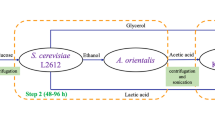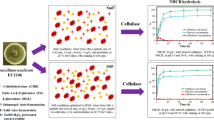Abstract
The conventional process for converting starch to glucose is energy-intensive. To lower the cost of this process, a novel strain of Paenibacillus phyllosphaerae CS-148 was isolated and identified, which could directly hydrolyze raw starch into glucose and accumulate glucose in the fermentation broth. The effects of different organic and inorganic nitrogen sources, the culture temperature, the initial pH, and the agitation speed on the yield of glucose were optimized through the one-factor-at-a-time method. Nine factors were screened by Plackett–Burman design, and three factors (raw corncob starch, yeast extract and (NH4)2SO4) had significant effects on glucose yield. Three significant factors were further optimized using Box-Behnken design. Under the optimized fermentation conditions (raw corncob starch 40.4 g/L, yeast extract 4.27 g/L, (NH4)2SO4 4.39 g/L, KH2PO4 2 g/L, MgSO4`7H2O 2 g/L, FeSO4`7H2O 0.02 g/L, NaCl 2 g/L, KCl 0.5 g/L, inoculums volume 4%, temperature 35 °C, agitation rate 150 rpm, and initial pH 7.0), the maximum glucose yield reached 17.32 ± 0.46 g/L, which is 1.33-fold compared to that by initial fermentation conditions. The maximum conversion rate and glucose productivity were 0.43 ± 0.01 g glucose/g raw corn starch and 0.22 ± 0.01 g/(L·h), respectively. These results implied that P. phyllosphaerae CS-148 could be used in the food industry or fermentation industry at a low cost.





Similar content being viewed by others
Data Availability
All the data generated or analyzed during this study are included in this published article.
References
Zhang, L., Zhong, L., Wang, J., Zhao, Y., Zhang, Y., Zheng, Y., Dong, W., Ye, X., Huang, Y., Li, Z., & Cui, Z. (2021). Efficient hydrolysis of raw starch by a maltohexaose-forming α-amylase from Corallococcus sp EGB. LWT, 152, 112361.
Song, W., Tong, Y., Li, Y., Tao, J., Li, J., Zhou, J., & Liu, S. (2021). Expression and characterization of a raw-starch glucoamylase from Aspergillus fumigatus. Process Biochemistry, 111, 97–104.
Fang, W., Xue, S., Deng, P., Zhang, X., Wang, X., Xiao, Y., & Fang, Z. (2019). AmyZ1: a novel α-amylase from marine bacterium Pontibacillus sp. ZY with high activity toward raw starches. Biotechnology for Biofuels, 12, 95.
Lin, H. J., Xian, L., Zhang, Q. J., Luo, X. M., Xu, Q. S., Yang, Q., Duan, C. J., Liu, J. L., Tang, J. L., & Feng, J. X. (2011). Production of raw cassava starch-degrading enzyme by Penicillium and its use in conversion of raw cassava flour to ethanol. Journal of Industrial Microbiology & Biotechnology, 38, 733–742.
Goyal, N., Gupta, J. K., & Soni, S. K. (2005). A novel raw starch digesting thermostable α-amylase from Bacillus sp. I-3 and its use in the direct hydrolysis of raw potato starch. Enzyme and Microbial Technology, 37, 723–734.
Nwagu, T., Lin, H. J., Xian, L., Zhang, Q. J., Luo, X. M., Xu, Q. S., Yang, Q., Duan, C. J., Liu, J. L., Tang, J. L., & Feng, J. X. (2012). Adsorption and stabilization of a raw sarch digesting amylase on micro bead silica Gel 300 A. British Biotechnology Journal, 2, 85–101.
Shofiyah, S. S., Yuliani, D., Widya, N., Sarian, F. D., Puspasari, F., Radjasa, O. K., & Ihsanawati, & Natalia D. (2020). Isolation, expression, and characterization of raw starch degrading α-amylase from a marine lake Bacillus megaterium NL3. Heliyon, 6, e05796.
Gu, L. H., Tan, M. Z., Li, S. H., Zhang, T., Zhang, Q. Q., Li, C. X., Luo, X. M., Feng, J. X., & Zhao, S. (2020). ARTP/EMS-combined multiple mutagenesis efficiently improved production of raw starch-degrading enzymes in Penicillium oxalicum and characterization of the enzyme-hyperproducing mutant. Biotechnology for Biofuels, 13, 187.
Lomthong, T., Chotineeranat, S., & Kitpreechavanich, V. (2015). Production and characterization of raw starch degrading enzyme from a newly isolated thermophilic filamentous bacterium, Laceyella sacchari LP175. Starch - Stärke, 67, 255–266.
Sun, H., & Peng, M. (2017). Improvement of glucoamylase production for raw-starch digestion in Aspergillus niger F-01 by maltose stearic acid ester. Biotechnology Letters, 39, 561–566.
Xie, F., Quan, S., Liu, D., Ma, H., Li, F., Zhou, F., & Chen, G. (2014). Purification and characterization of a novel α-amylase from a newly isolated Bacillus methylotrophicus strain P11-2. Process Biochemistry, 49, 47–53.
Finore, I., Kasavi, C., Poli, A., Romano, I., Oner, E. T., Kirdar, B., Dipasquale, L., Nicolaus, B., & Lama, L. (2011). Purification, biochemical characterization and gene sequencing of a thermostable raw starch digesting α-amylase from Geobacillus thermoleovorans subsp. stromboliensis subsp. nov. World Journal of Microbiology and Biotechnology, 27, 2425–2433.
Duque, S. M. M., Dizon, E. I., Merca, F. E., & Flores, D. M. (2016). Optimization of raw-starch-digesting amylase (RSDA) production medium for Enterococcus faecium DMF78. International Food Research Journal, 23, 1280–1288.
Tang, S., Xu, T., Peng, J., Zhou, K., Zhu, Y., Zhou, W., Cheng, H., & Zhou, H. (2020). Overexpression of an endogenous raw starch digesting mesophilic α-amylase gene in Bacillus amyloliquefaciens Z3 by in vitro methylation protocol. Journal of the Science of Food and Agriculture, 100, 3013–3023.
Buchanan, R. E., & Gibbons, N. E. (1984). Bergey’s manual of determinative bacteriology (8th ed.). Beijing, China: Science Press.
Rivas, R., Mateos, P. F., Martínez-Molina, E., & Velázquez, E. (2005). Paenibacillus phyllosphaerae sp. nov., a xylanolytic bacterium isolated from the phyllosphere of Phoenix dactylifera. International Journal of Systematic and Evolutionary Microbiology, 55, 743–746.
Bhaturiwala, R., Bagban, M., Mansuri, A., & Modi, H. (2022). Successive approach of medium optimization using one-factor-at-a-time and response surface methodology for improved β-mannanase production from Streptomyces sp. Bioresource technology, 18, 101087.
Zhao, H., Xia, J., Wang, J., Yan, X., Wang, C., Lei, T., Xian, M., & Zhang, H. (2018). Production of bacterial cellulose using polysaccharide fermentation wastewater as inexpensive nutrient sources. Biotechnology and Biotechnological Equipment, 32, 350–356.
Govindaraju, I., Chakraborty, I., Baruah, V. J., Sarmah, B., Mahato, K. K., & Mazumder, N. (2021). Structure and morphological properties of starch macromolecule using biophysical techniques. Starch - Stärke, 73, 2000030.
Roldán, D. M., Costa, A., Králová, S., Busse, H.-J., Amarelle, V., Fabiano, E., & Menes, R. J. (2022). Paenibacillus farraposensis sp. nov., isolated from a root nodule of Arachis villosa. International Journal of Systematic and Evolutionary Microbiology, 72, 005294.
Sáez-Nieto, J. A., Medina-Pascual, M. J., Carrasco, G., Garrido, N., Fernandez-Torres, M. A., Villalón, P., & Valdezate, S. (2017). Paenibacillus spp. isolated from human and environmental samples in Spain: Detection of 11 new species. New Microbes and New Infections, 19, 19–27.
Aw, Y.-K., Ong, K.-S., Lee, L.-H., Cheow, Y.-L., Yule, C. M., & Lee, S.-M. (2016). Newly isolated Paenibacillus tyrfis sp. nov., from Malaysian tropical Peat swamp soil with broad spectrum antimicrobial activity. Frontiers in Microbiology, 7, 219.
Priest, F. G. (2015). Paenibacillus. In S. D. M. E. Trujillo, P. DeVos, B. Hedlund, P. Kämpfer, F. A. Rainey, & W. B. Whitman (Eds.), Bergey’s Manual of Systematics of Archaea and Bacteria (pp. 1–40). New York: Wiley.
Beveridge, T. J. (2001). Use of the Gram stain in microbiology. Biotechnic & Histochemistry, 76, 111–118.
Liang, T. W., & Wang, S. L. (2015). Recent advances in exopolysaccharides from Paenibacillus spp.: Production, isolation, structure, and bioactivities. Marine Drugs, 13, 1847–1863.
Häßler, T., Schieder, D., Pfaller, R., Faulstich, M., & Sieber, V. (2012). Enhanced fed-batch fermentation of 2,3-butanediol by Paenibacillus polymyxa DSM 365. Bioresource Technology, 124, 237–244.
Zhang, X., Li, H., Kang, X., Lim, S., & Li, F. (2021). Isolation, identification and optimization of fermentation conditions against Sclerotinia sclerotiorum strains in high salt Doenjang. Food Science and Human Wellness, 10, 205–213.
Rahman, S. S. A., Pasupathi, S., & Karuppiah, S. (2022). Conventional optimization and characterization of microbial dextran using treated sugarcane molasses. International Journal of Biological Macromolecules, 220, 775–787.
Choudhury, A. R., Sharma, N., & Prasad, G. S. (2012). Deoiledjatropha seed cake is a useful nutrient for pullulan production. Microbial Cell Factories, 11, 39.
Funding
This work was supported by the Major Basic Research Project of the Natural Science Foundation of the Jiangsu Higher Education Institutions (18KJA550001).
Author information
Authors and Affiliations
Contributions
GY: funding acquisition, conceptualization, supervision, investigation, writing—original draft; YZ: supervision, writing—review and editing; CJ: methodology; JW: funding acquisition; LZ: resources; WW: data curation
Corresponding author
Ethics declarations
Ethical Approval
Not applicable.
Consent to Participate
Not applicable.
Consent for Publication
All authors have their consent to publish their work.
Competing Interests
The authors declare no competing interests.
Additional information
Publisher’s Note
Springer Nature remains neutral with regard to jurisdictional claims in published maps and institutional affiliations.
Rights and permissions
Springer Nature or its licensor (e.g. a society or other partner) holds exclusive rights to this article under a publishing agreement with the author(s) or other rightsholder(s); author self-archiving of the accepted manuscript version of this article is solely governed by the terms of such publishing agreement and applicable law.
About this article
Cite this article
Yan, G., Zhou, Y., Wu, J. et al. Novel Strain of Paenibacillus phyllosphaerae CS-148 for the Direct Hydrolysis of Raw Starch into Glucose: Isolation and Fermentation Optimization. Appl Biochem Biotechnol (2023). https://doi.org/10.1007/s12010-023-04750-0
Accepted:
Published:
DOI: https://doi.org/10.1007/s12010-023-04750-0




